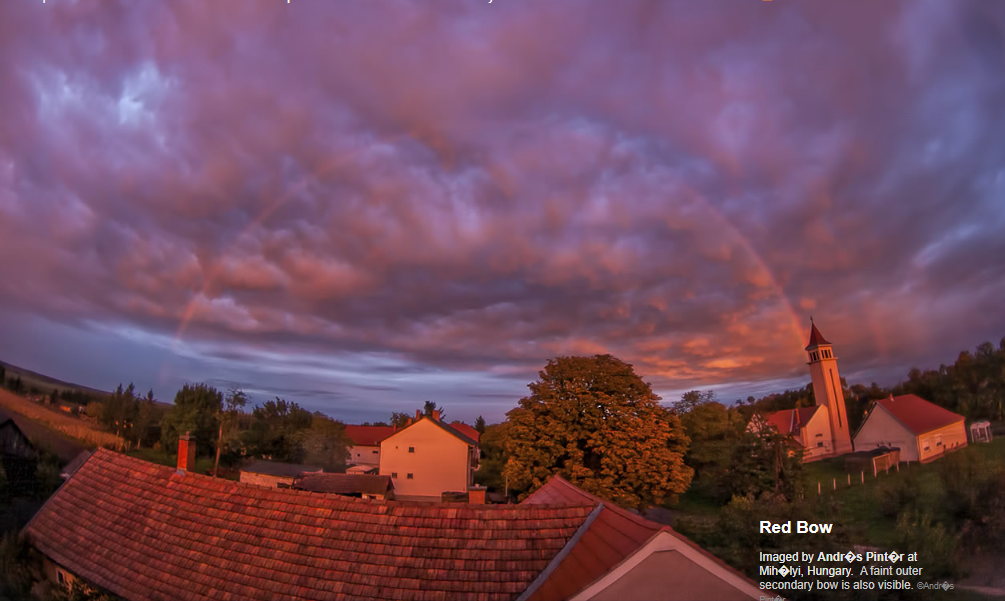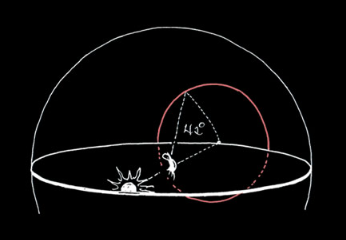Red rainbow - OPOD
Red Rainbow - OPOD: A Spectacular Phenomenon
Have you ever witnessed a red rainbow during sunrise or sunset? These magical moments occur when raindrops in the atmosphere are perfectly positioned to create a semi-circular bow of vivid red hues. While rainbows are a common sight after rainfall, red rainbows are a rare and captivating phenomenon that deserve our attention.
When the sun is low on the horizon during sunrise or sunset, and there is a sufficient spread of rain opposite the sun, a complete semi-circular bow can appear high in the sky. This is when the magic begins. The highly reddened light from the setting or rising sun bathes the landscape, creating an enchanting atmosphere. The result is a narrow red-hued rainbow with subtle traces of other colors.
The intense red coloration of these rainbows is caused by the scattering of sunlight by small dust particles and air molecules present in the atmosphere. We are familiar with the scattering of blue light that gives us our beautiful blue skies during the day. However, during sunset, the longer atmospheric path that sunlight takes allows for preferential scattering of blues and greens, leaving behind a reddened light that dominates the scene.
To fully appreciate the beauty of red rainbows, it is important to understand the science behind this phenomenon. The reddening effect is a result of a process known as Rayleigh scattering. As sunlight passes through the Earth's atmosphere, it interacts with the molecules and particles present. The shorter wavelengths of light, such as blue and green, are scattered more strongly than the longer wavelengths, such as red. This selective scattering leads to the dominance of red hues during sunrise and sunset, giving rise to the captivating red rainbow.
It's important to note that red rainbows are relatively rare compared to their more common counterparts. The perfect alignment of raindrops, sunlight, and atmospheric conditions is necessary for their formation. Therefore, witnessing a red rainbow is truly a special and awe-inspiring event.
To capture the beauty of red rainbows, photographers often seize the opportunity during sunrise or sunset. The combination of the vibrant red hues and the natural landscape creates stunning visual compositions. One such example is the photograph taken by András Pintér in Mihályi, Hungary, where a faint outer secondary bow is also visible, adding an extra touch of splendor to the scene.
In conclusion, red rainbows are a captivating atmospheric optics phenomenon that occur during sunrise or sunset. The reddened light from the setting or rising sun, combined with selective scattering of shorter wavelengths, creates a narrow rainbow dominated by vivid red hues. While rare, witnessing a red rainbow is a truly magical experience. Photographers often seek to capture the beauty of these moments, resulting in breathtaking images that showcase nature's wonders. So, keep an eye out during those golden hours and be ready to witness the extraordinary beauty of a red rainbow.

Red Bow
Imaged by Andr�s Pint�r at Mih�lyi, Hungary. A faint outer secondary bow is also visible. ©Andr�s Pint�r

Sunset and sunrise are special times for rainbows. With the proper spread of rain opposite the sun a complete semi-circular bow shows high in the sky.
Highly reddened sunset light suffuses the landscape and casts a narrow red hued rainbow with only traces of other colours.
The reddening is from scattering of sunlight by small dust particles and the air molecules themselves. The air scattering that gives us blue skies has its complement in sunset hues. Blues and greens are preferentially scattered from the long atmosperic path sunset rays to leave reddened light.
Note: this article has been automatically converted from the old site and may not appear as intended. You can find the original article here.
Reference Atmospheric Optics
If you use any of the definitions, information, or data presented on Atmospheric Optics, please copy the link or reference below to properly credit us as the reference source. Thank you!
-
<a href="https://atoptics.co.uk/blog/red-rainbow-opod/">Red rainbow - OPOD</a>
-
"Red rainbow - OPOD". Atmospheric Optics. Accessed on April 18, 2024. https://atoptics.co.uk/blog/red-rainbow-opod/.
-
"Red rainbow - OPOD". Atmospheric Optics, https://atoptics.co.uk/blog/red-rainbow-opod/. Accessed 18 April, 2024
-
Red rainbow - OPOD. Atmospheric Optics. Retrieved from https://atoptics.co.uk/blog/red-rainbow-opod/.